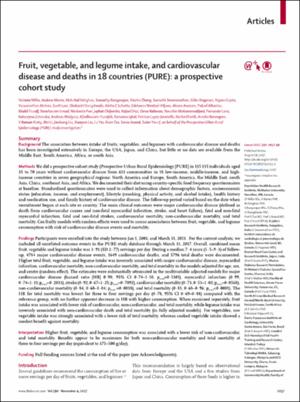| dc.description.abstract | Summary
Background
The association between intake of fruits, vegetables, and legumes with cardiovascular disease and deaths has been investigated extensively in Europe, the USA, Japan, and China, but little or no data are available from the Middle East, South America, Africa, or south Asia.
Methods
We did a prospective cohort study (Prospective Urban Rural Epidemiology [PURE] in 135 335 individuals aged 35 to 70 years without cardiovascular disease from 613 communities in 18 low-income, middle-income, and high-income countries in seven geographical regions: North America and Europe, South America, the Middle East, south Asia, China, southeast Asia, and Africa. We documented their diet using country-specific food frequency questionnaires at baseline. Standardised questionnaires were used to collect information about demographic factors, socioeconomic status (education, income, and employment), lifestyle (smoking, physical activity, and alcohol intake), health history and medication use, and family history of cardiovascular disease. The follow-up period varied based on the date when recruitment began at each site or country. The main clinical outcomes were major cardiovascular disease (defined as death from cardiovascular causes and non-fatal myocardial infarction, stroke, and heart failure), fatal and non-fatal myocardial infarction, fatal and non-fatal strokes, cardiovascular mortality, non-cardiovascular mortality, and total mortality. Cox frailty models with random effects were used to assess associations between fruit, vegetable, and legume consumption with risk of cardiovascular disease events and mortality.
Findings
Participants were enrolled into the study between Jan 1, 2003, and March 31, 2013. For the current analysis, we included all unrefuted outcome events in the PURE study database through March 31, 2017. Overall, combined mean fruit, vegetable and legume intake was 3·91 (SD 2·77) servings per day. During a median 7·4 years (5·5–9·3) of follow-up, 4784 major cardiovascular disease events, 1649 cardiovascular deaths, and 5796 total deaths were documented. Higher total fruit, vegetable, and legume intake was inversely associated with major cardiovascular disease, myocardial infarction, cardiovascular mortality, non-cardiovascular mortality, and total mortality in the models adjusted for age, sex, and centre (random effect). The estimates were substantially attenuated in the multivariable adjusted models for major cardiovascular disease (hazard ratio [HR] 0·90, 95% CI 0·74–1·10, ptrend=0·1301), myocardial infarction (0·99, 0·74–1·31; ptrend=0·2033), stroke (0·92, 0·67–1·25; ptrend=0·7092), cardiovascular mortality (0·73, 0·53–1·02; ptrend=0·0568), non-cardiovascular mortality (0·84, 0·68–1·04; ptrend =0·0038), and total mortality (0·81, 0·68–0·96; ptrend<0·0001). The HR for total mortality was lowest for three to four servings per day (0·78, 95% CI 0·69–0·88) compared with the reference group, with no further apparent decrease in HR with higher consumption. When examined separately, fruit intake was associated with lower risk of cardiovascular, non-cardiovascular, and total mortality, while legume intake was inversely associated with non-cardiovascular death and total mortality (in fully adjusted models). For vegetables, raw vegetable intake was strongly associated with a lower risk of total mortality, whereas cooked vegetable intake showed a modest benefit against mortality.
Interpretation
Higher fruit, vegetable, and legume consumption was associated with a lower risk of non-cardiovascular, and total mortality. Benefits appear to be maximum for both non-cardiovascular mortality and total mortality at three to four servings per day (equivalent to 375–500 g/day).
Funding
Full funding sources listed at the end of the paper (see Acknowledgments). | en_US |
